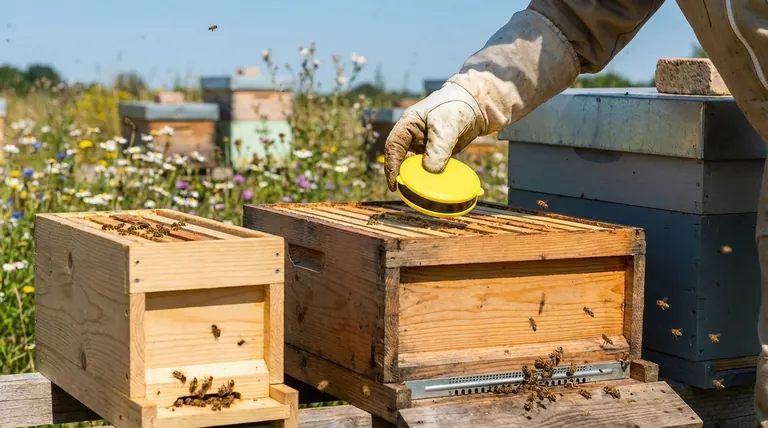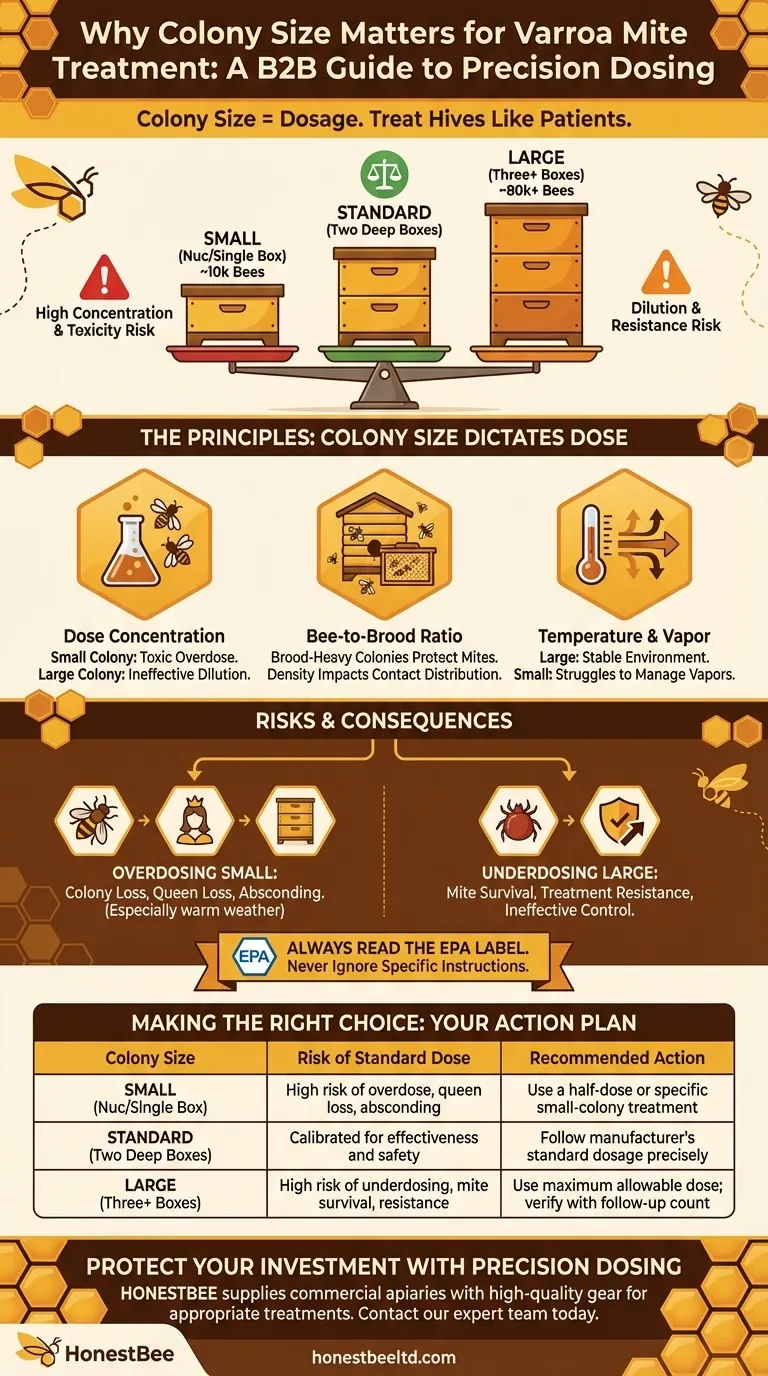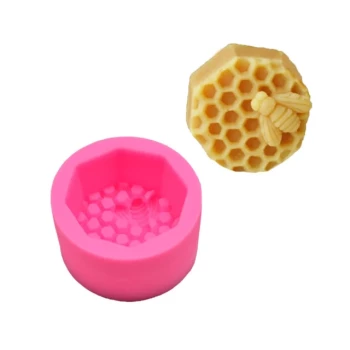In short, colony size is a critical factor because mite treatments are effectively a form of medication. Applying a dose designed for a massive, 80,000-bee colony to a small, 10,000-bee nucleus hive can be toxic and potentially kill the queen or cause the entire colony to abscond. Conversely, under-dosing a large colony results in ineffective treatment, allowing mites to survive and develop resistance.
The core challenge of Varroa treatment is achieving a chemical concentration that is lethal to mites but safe for bees. Because colony size directly determines the volume and population being treated, it is the single most important variable for calculating the correct, effective, and safe dosage.

The Principles Dictated by Colony Size
To effectively manage Varroa mites, you must move beyond simply applying a product and think like a pharmacologist. The hive is a patient, and the colony's size (its "body weight") dictates the dose.
Dose Concentration and Toxicity
A Varroa treatment's effectiveness hinges on achieving a specific concentration of its active ingredient within the hive.
For a small colony, like a single-box hive or a nucleus, a standard treatment strip or vapor application can create a dangerously high concentration. The smaller number of bees and reduced air volume means each bee is exposed to a much higher, potentially toxic, dose.
For a very large colony, such as a hive with three or four boxes teeming with bees, a standard dose may be diluted to the point of being ineffective. Not enough active ingredient will be distributed to kill a sufficient percentage of the mite population.
Bee-to-Brood Ratio Dynamics
Many Varroa mites are not on the adult bees (phoretic mites) but are reproducing under capped brood. Treatments that work via contact, like Apivar strips, rely on bees touching the strips and then spreading the active ingredient throughout the hive.
In a "brood-heavy" colony, a larger proportion of mites are protected from these treatments. While colony size doesn't always correlate perfectly, the dynamics of bee movement and density change. A densely packed, large colony may distribute a contact chemical more efficiently than a sparse, smaller one.
Temperature, Ventilation, and Vapor
Treatments that work via vaporization—such as those using formic acid or thymol—are highly dependent on the colony's ability to manage its internal temperature and ventilation.
A large, populous colony has a stable internal environment. It can effectively circulate the treatment vapors.
A small, weak colony struggles to maintain temperature and may have poor ventilation. In this scenario, vapors can become too concentrated in one area, killing brood and bees, or fail to disperse, rendering the treatment useless.
Understanding the Trade-offs and Risks
Failing to adjust for colony size is not a neutral mistake; it has direct and severe consequences for your bees and your management strategy.
The Danger of Overdosing Small Colonies
The most immediate risk is colony loss. Applying a full dose to a small nucleus colony can lead to acute toxicity.
Signs of overdosing include dead bees on the bottom board, queen loss, and bees absconding (abandoning the hive entirely). This is especially true for temperature-sensitive treatments applied during warm weather.
The Risk of Underdosing Large Colonies
Underdosing a strong hive is a more subtle but equally damaging error. The treatment may kill some mites, but it will not reduce the population below the critical threshold for colony health.
Worse, exposing a mite population to a sub-lethal dose is the classic recipe for creating treatment-resistant mites. The survivors pass on their resilient genetics, making future treatments in your apiary less effective.
Always Read the EPA Label
The manufacturer's EPA-approved label is your primary guide. It is a legal document that contains specific instructions based on extensive testing. Often, these labels will provide directions for using partial doses or different application methods for smaller colonies. Never ignore these instructions.
Making the Right Choice for Your Apiary
After performing a mite count to confirm treatment is necessary, use the colony's size to determine your application strategy.
- If you are treating a small nucleus (nuc) or a single-deep hive: Use a half-dose or a treatment method specifically approved for smaller colonies, and monitor the entrance for any signs of distress.
- If you are treating a standard, two-deep brood box colony: Follow the manufacturer's standard dosage instructions precisely, as this is the hive size for which most treatments are calibrated.
- If you are treating an exceptionally large colony (three or more boxes): Ensure you are using the maximum allowable dose per the label and consider a follow-up mite count to verify efficacy, as dilution is a real risk.
Ultimately, adjusting treatment based on colony size is a hallmark of responsible and effective beekeeping.
Summary Table:
| Colony Size | Risk of Standard Dose | Recommended Action |
|---|---|---|
| Small (Nuc/Single Box) | High risk of overdose, queen loss, absconding | Use a half-dose or specific small-colony treatment |
| Standard (Two Deep Boxes) | Calibrated for effectiveness and safety | Follow manufacturer's standard dosage precisely |
| Large (Three+ Boxes) | High risk of underdosing, mite survival, resistance | Use maximum allowable dose; verify with follow-up count |
Protect Your Investment with Precision Dosing
Managing varroa mites effectively requires the right tools and knowledge. At HONESTBEE, we supply commercial apiaries and beekeeping equipment distributors with the high-quality, reliable supplies needed for precise, colony-size-appropriate mite treatments.
From calibrated treatment strips to essential safety equipment, our wholesale-focused operations ensure you get the gear you need to keep your hives healthy and productive.
Contact our expert team today to discuss your apiary's specific needs and how our products can support your integrated pest management strategy.
Visual Guide

Related Products
- Adjustable Formic and Acetic Acid Dispenser for Bee Mite Treatment
- Professional Bamboo Queen Isolation Cage
- Varroa Easy Check Mite Tester Kit Counter Alcohol Wash Jar
- Professional Galvanized Hive Strap with Secure Locking Buckle for Beekeeping
- Metal Queen Bee Excluder for Beekeeping
People Also Ask
- What does Chewed Down Brood (CDB) indicate in bee colonies? A Sign of Varroa Mite Infestation
- What is the focus of hive management during summer? Maximize Your Honey Harvest with Expert Tips
- How can beekeepers ensure their hives survive the winter? A Guide to Colony Survival
- What should be done after treating a colony for varroa mites? A Step-by-Step Guide to Verifying Success
- What is the optimal time for varroa mite control in nucs? Maximize Efficacy with Perfect Timing



















